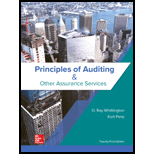
EBK PRINCIPLES OF AUDITING & OTHER ASSU
21st Edition
ISBN: 9781260299434
Author: WHITTINGTON
Publisher: YUZU
expand_more
expand_more
format_list_bulleted
Concept explainers
Textbook Question
Chapter 6, Problem 16RQ
What is meant by making a proper year-end cutoff? Explain the effects of errors in the cutoff of sales transactions in both the income statement and the
Expert Solution & Answer
Want to see the full answer?
Check out a sample textbook solution
Students have asked these similar questions
need help this questions
provide correct answer
hello tutor please help me
Chapter 6 Solutions
EBK PRINCIPLES OF AUDITING & OTHER ASSU
Ch. 6 - Prob. 1RQCh. 6 - Prob. 2RQCh. 6 - Prob. 3RQCh. 6 - Discuss what is meant by the phrase shopping for...Ch. 6 - Prob. 5RQCh. 6 - Prob. 6RQCh. 6 - Prob. 7RQCh. 6 - Prob. 8RQCh. 6 - Prob. 9RQCh. 6 - Prob. 10RQ
Ch. 6 - Prob. 11RQCh. 6 - Prob. 12RQCh. 6 - Prob. 13RQCh. 6 - Prob. 14RQCh. 6 - Prob. 15RQCh. 6 - What is meant by making a proper year-end cutoff?...Ch. 6 - Prob. 17RQCh. 6 - Prob. 18RQCh. 6 - Prob. 19RQCh. 6 - Prob. 20RQCh. 6 - Auditing standards require the auditors to have a...Ch. 6 - Prob. 22RQCh. 6 - Prob. 23RQCh. 6 - Prob. 24QRACh. 6 - Prob. 25QRACh. 6 - Prob. 26QRACh. 6 - Prob. 27QRACh. 6 - Prob. 28QRACh. 6 - Prob. 29QRACh. 6 - Prob. 30QRACh. 6 - Prob. 31QRACh. 6 - Prob. 32QRACh. 6 - Prob. 33QRACh. 6 - Prob. 34QRACh. 6 - Prob. 35QRACh. 6 - Prob. 36QRACh. 6 - Prob. 37QRACh. 6 - Prob. 38AOQCh. 6 - Prob. 38BOQCh. 6 - Prob. 38COQCh. 6 - Prob. 38DOQCh. 6 - Prob. 38EOQCh. 6 - Prob. 38FOQCh. 6 - Prob. 38GOQCh. 6 - Prob. 38HOQCh. 6 - Prob. 38IOQCh. 6 - Prob. 38JOQCh. 6 - Prob. 38KOQCh. 6 - Prob. 38LOQCh. 6 - Prob. 39OQCh. 6 - Prob. 40OQCh. 6 - Prob. 41OQCh. 6 - Prob. 42AOQCh. 6 - Prob. 42BOQCh. 6 - Prob. 42COQCh. 6 - Tracing from source documents to journals most...Ch. 6 - Vouching from journals (or ledgers) to source...Ch. 6 - For each definition (or portion of a definition)...Ch. 6 - Prob. 44PCh. 6 - Prob. 45PCh. 6 - Tammy Potter, a new partner with the regional CPA...
Knowledge Booster
Learn more about
Need a deep-dive on the concept behind this application? Look no further. Learn more about this topic, accounting and related others by exploring similar questions and additional content below.Similar questions
arrow_back_ios
SEE MORE QUESTIONS
arrow_forward_ios
Recommended textbooks for you
 Cornerstones of Financial AccountingAccountingISBN:9781337690881Author:Jay Rich, Jeff JonesPublisher:Cengage LearningPrinciples of Accounting Volume 1AccountingISBN:9781947172685Author:OpenStaxPublisher:OpenStax College
Cornerstones of Financial AccountingAccountingISBN:9781337690881Author:Jay Rich, Jeff JonesPublisher:Cengage LearningPrinciples of Accounting Volume 1AccountingISBN:9781947172685Author:OpenStaxPublisher:OpenStax College College Accounting (Book Only): A Career ApproachAccountingISBN:9781337280570Author:Scott, Cathy J.Publisher:South-Western College Pub
College Accounting (Book Only): A Career ApproachAccountingISBN:9781337280570Author:Scott, Cathy J.Publisher:South-Western College Pub College Accounting (Book Only): A Career ApproachAccountingISBN:9781305084087Author:Cathy J. ScottPublisher:Cengage LearningCentury 21 Accounting Multicolumn JournalAccountingISBN:9781337679503Author:GilbertsonPublisher:Cengage
College Accounting (Book Only): A Career ApproachAccountingISBN:9781305084087Author:Cathy J. ScottPublisher:Cengage LearningCentury 21 Accounting Multicolumn JournalAccountingISBN:9781337679503Author:GilbertsonPublisher:Cengage

Cornerstones of Financial Accounting
Accounting
ISBN:9781337690881
Author:Jay Rich, Jeff Jones
Publisher:Cengage Learning

Principles of Accounting Volume 1
Accounting
ISBN:9781947172685
Author:OpenStax
Publisher:OpenStax College

College Accounting (Book Only): A Career Approach
Accounting
ISBN:9781337280570
Author:Scott, Cathy J.
Publisher:South-Western College Pub

College Accounting (Book Only): A Career Approach
Accounting
ISBN:9781305084087
Author:Cathy J. Scott
Publisher:Cengage Learning

Century 21 Accounting Multicolumn Journal
Accounting
ISBN:9781337679503
Author:Gilbertson
Publisher:Cengage
Chapter 6 Merchandise Inventory; Author: Vicki Stewart;https://www.youtube.com/watch?v=DnrcQLD2yKU;License: Standard YouTube License, CC-BY
Accounting for Merchandising Operations Recording Purchases of Merchandise; Author: Socrat Ghadban;https://www.youtube.com/watch?v=iQp5UoYpG20;License: Standard Youtube License